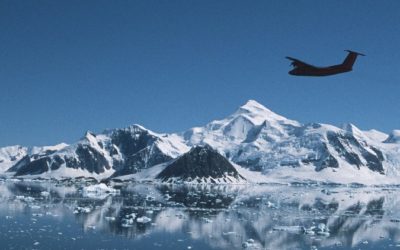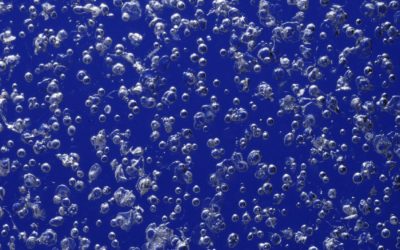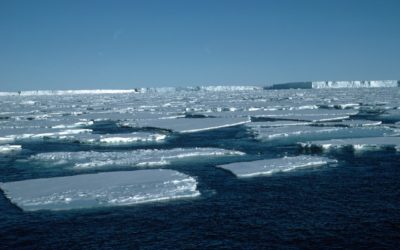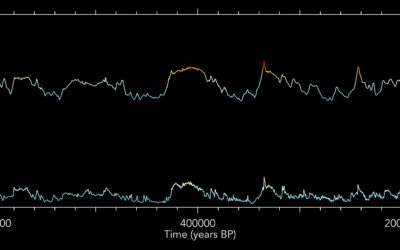
Ice Core Gas Lab
Specialist ice core facility to measure concentration and isotopic composition of greenhouse gases
BAS provides the UK’s only capability to recover and analyse ice cores (up to 1000 m). We provide ice core drills for deployment by research teams around the world, and operate state-of-the-art laboratories in Cambridge to provide a wide range of climatologically and environmentally-relevant chemical, gas and stable isotope analyses.
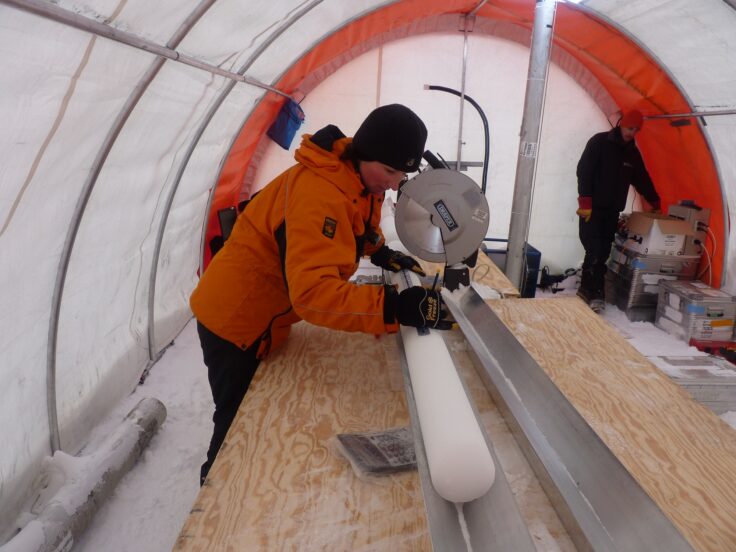
Ice cores from Antarctica, the Arctic and mi-latitude locations are drilled, processed and analysed by BAS scientists and engineers. Laboratory facilities in Cambridge allow the analysis and interpretation of ice cores dating from hundreds to hundreds of thousands of years old. The current facilities allow ice to be stored, processed, and analysed, using a number of analytical chemistry, isotopic and gas extraction techniques to provide information from the past to help to predict the future.
The interpretation of ice core records including climate and atmospheric modelling studies, aimed both at improving ice core proxies, and understanding the couplings and interactions between different parts of the earth-system.
A bespoke Continuous Flow Analysis (CFA) method coupled to a suite of instruments and detectors including:
Take a tour of the ice core labs:
Click here for a virtual tour of the labs and meet some of the team.
Ice core data stored at the UK Polar Data Centre:
Recent ice core papers:
Thomas, Elizabeth R. , Vladimirova, Diana O. , Tetzner, Dieter R. , Emanuelsson, B. Daniel , Chellman, Nathan, Dixon, Daniel A., Goosse, Hugues, Grieman, Mackenzie M., King, Amy C.F. , Sigl, Michael, Udy, Danielle G., Vance, Tessa R., Winski, Dominic A., Winton, V. Holly L., Bertler, Nancy A.N., Hori, Akira, Laluraj, Chavarukonam M., McConnell, Joseph R., Motizuki, Yuko, Takahashi, Kazuya, Motoyama, Hideaki, Nakai, Yoichi, Schwanck, Franciéle, Simões, Jefferson Cardia, Gaudie Ley Lindau, Filipe, Severi, Mirko, Traversi, Rita, Wauthy, Sarah, Xiao, Cunde, Yang, Jiao, Mosely-Thompson, Ellen, Khodzher, Tamara V., Golobokova, Ludmila P., Ekaykin, Alexey A.. (2023) Ice core chemistry database: an Antarctic compilation of sodium and sulfate records spanning the past 2000 years. Earth System Science Data, 15. 2517-2532. 10.5194/essd-15-2517-2023
Thomas, Elizabeth Ruth , Tetzner, Dieter , Markle, Bradley, Pedro, Joel, Gacitúa, Guisella, Moser, Dorothea Elisabeth , Jackson, Sarah. (2023) The first firn core from Peter 1st Island – capturing climate variability across the Bellingshausen Sea. Climate of the Past: Discussions. 10.5194/egusphere-2023-1064
Emanuelsson, B. Daniel , Renwick, James A., Bertler, Nancy A. N., Baisden, W. Troy, Thomas, Elizabeth R. . (2023) The role of large-scale drivers in the Amundsen Sea Low variability and associated changes in water isotopes from the Roosevelt Island ice core, Antarctica. Climate Dynamics, 60. 4145-4155. 10.1007/s00382-022-06568-8
Hartz, William F., Björnsdotter, Maria K., Yeung, Leo W.Y., Hodson, Andrew, Thomas, Elizabeth R. , Humby, Jack D. , Day, Chris, Jogsten, Ingrid Ericson, Kärrman, Anna, Kallenborn, Roland. (2023) Levels and distribution profiles of Per- and Polyfluoroalkyl Substances (PFAS) in a high Arctic Svalbard ice core. Science of the Total Environment, 871. 12 pp. 10.1016/j.scitotenv.2023.161830
Thomas, E.R. , Tetzner, D.R. , Roberts, S.L., Turner, S.D., Rose, N.L.. (2023) First evidence of industrial fly-ash in an Antarctic ice core. Scientific Reports, 13. 5 pp. 10.1038/s41598-023-33849-x
Thomas, Elizabeth R.. , Vladimirova, Diana O., Tetzner, Dieter R. , Emanuelsson, Daniel B. , Humby, Jack , Turner, Simon D., Rose, Neil L., Roberts, Sarah L., Gaca, Pawel, Cundy, Andrew B.. (2023) The Palmer ice core as a candidate Global boundary Stratotype Section and Point for the Anthropocene series. The Anthropocene Review, 10. 30 pp. 10.1177/20530196231155191
Brown, Joseph W., Moser, Dorothea E. , Emanuelsson, Daniel B. , Thomas, Elizabeth R. . (2023) Visual Stratigraphy-Based Age Scale Developed for the Shallow Mount Siple Firn Core, Antarctica. Geosciences, 13. 10.3390/geosciences13030085
Wang, Yetang, Zhang, Xueying, Ning, Wentao, Lazzara, Matthew A., Ding, Minghu, Reijmer, Carleen H., Smeets, Paul C.J.P., Grigioni, Paolo, Heil, Petra, Thomas, Elizabeth R. , Mikolajczyk, David, Welhouse, Lee J., Keller, Linda M., Zhai, Zhaosheng, Sun, Yuqi, Hou, Shugui. (2023) The AntAWS dataset: a compilation of Antarctic automatic weather station observations. Earth System Science Data, 15. 19 pp. 10.5194/essd-15-411-2023
Rowell, Isobel F., Mulvaney, Robert , Rix, Julius , Tetzner, Dieter R. , Wolff, Eric W.. (2023) Viability of chemical and water isotope ratio measurements of RAID ice chippings from Antarctica. Journal of Glaciology, 69. 16 pp. 10.1017/jog.2022.94
Emanuelsson, B. Daniel , Thomas, Elizabeth R. , Humby, Jack D. , Vladimirova, Diana O. . (2022) Decadal Scale Variability of Larsen Ice Shelf Melt Captured by Antarctic Peninsula Ice Core. Geosciences, 12. 12 pp. 10.3390/geosciences12090344
Hoffmann, Helene M., Grieman, Mackenzie M., King, Amy C.F. , Epifanio, Jenna A., Martin, Kaden, Vladimirova, Diana, Pryer, Helena, Doyle, Emily, Schmidt, Axel, Humby, Jack D. , Rowell, Isobel F., Nehrbass-Ahles, Christoph, Thomas, Elizabeth R. , Mulvaney, Robert , Wolff, Eric W.. (2022) The ST22 chronology for the Skytrain Ice Rise ice core – Part 1: A stratigraphic chronology of the last 2000 years. Climate of the Past, 18. 17 pp. 10.5194/cp-18-1831-2022
Jones, Richard S., Johnson, Joanne S. , Lin, Yucheng, Mackintosh, Andrew N., Sefton, Juliet P., Smith, James A. , Thomas, Elizabeth R. , Whitehouse, Pippa L.. (2022) Stability of the Antarctic Ice Sheet during the pre-industrial Holocene. Nature Reviews Earth & Environment, 3. 16 pp. 10.1038/s43017-022-00309-5
Tetzner, Dieter R. , Thomas, Elizabeth R. , Allen, Claire S. , Grieman, Mackenzie M.. (2022) Regional validation of the use of diatoms in ice cores from the Antarctic Peninsula as a Southern Hemisphere westerly wind proxy. Climate of the Past, 18. 1709-1727. 10.5194/cp-18-1709-2022
Turner, John , Holmes, Caroline , Caton Harrison, Thomas , Phillips, Tony , Jena, Babula, Reeves-Francois, Tylei, Fogt, Ryan, Thomas, Elizabeth R. , Bajish, C.C.. (2022) Record low Antarctic sea ice cover in February 2022. Geophysical Research Letters, 49. 11 pp. 10.1029/2022GL098904
Johnson, Joanne S. , Venturelli, Ryan A., Balco, Greg, Allen, Claire S. , Braddock, Scott, Campbell, Seth, Goehring, Brent M., Hall, Brenda L., Neff, Peter D., Nichols, Keir A., Rood, Dylan H., Thomas, Elizabeth R. , Woodward, John. (2022) Existing and potential evidence for Holocene grounding line retreat and readvance in Antarctica. The Cryosphere, 16. 1543-1562. 10.5194/tc-16-1543-2022
Erhardt, T., Bigler, M., Federer, U., Gfeller, G., Leuenberger, D., Stowasser, O., Röthlisberger, R., Schüpbach, S., Ruth, U., Twarloh, B., Wegner, A., Goto-Azuma, K., Kuramoto, T., Kjær, H.A., Vallelonga, P.T., Siggaard-Andersen, M-L., Hansson, M.E., Benton, A.K., Fleet, L.G., Mulvaney, R. , Thomas, E.R. , Abram, N., Stocker, T.F., Fischer, H.. (2022) High-resolution aerosol concentration data from the Greenland NorthGRIP and NEEM deep ice cores. Earth System Science Data, 14. 1215-1231. 10.5194/essd-14-1215-2022
Tetzner, Dieter R. , Allen, Claire S. , Thomas, Elizabeth R. . (2022) Regional variability of diatoms in ice cores from the Antarctic Peninsula and Ellsworth Land, Antarctica. The Cryosphere, 16. 779-798. 10.5194/tc-16-779-2022
Emanuelsson, B. Daniel , Thomas, Elizabeth R. , Tetzner, Dieter R. , Humby, Jack D. , Vladimirova, Diana O. . (2022) Ice core chronologies from the Antarctic Peninsula: The Palmer, Jurassic, and Rendezvous age-scales. Geosciences, 12. 10.3390/geosciences12020087
Grieman, Mackenzie M., Hoffmann, Helene M., Humby, Jack D. , Mulvaney, Robert , Nehrbass-Ahles, Christoph, Rix, Julius , Thomas, Elizabeth R. , Tuckwell, Rebecca , Wolff, Eric W.. (2022) Continuous flow analysis methods for sodium, magnesium and calcium detection in the Skytrain ice core. Journal of Glaciology, 68. 90-100. 10.1017/jog.2021.75
Tetzner, Dieter R. , Thomas, Elizabeth R. , Allen, Claire S. , Permattei, Alma. (2021) Evidence of recent active volcanism in the Balleny Islands (Antarctica) from ice core records. Journal of Geophysical Research: Atmospheres, 126. 20 pp. 10.1029/2021JD035095
Dalaiden, Quentin, Goosse, Hugues, Rezsöhazy, Jeanne, Thomas, Elizabeth R. . (2021) Reconstructing atmospheric circulation and sea-ice extent in the West Antarctic over the past 200 years using data assimilation. Climate Dynamics, 57. 3479-3503. 10.1007/s00382-021-05879-6
Simms, Alexander R., Bentley, Michael J., Simkins, Lauren M., Zurbuchen, Julie, Reynolds, Laura C., DeWitt, Regina, Thomas, Elizabeth R. . (2021) Evidence for a “Little Ice Age” glacial advance within the Antarctic Peninsula – Examples from glacially-overrun raised beaches. Quaternary Science Reviews, 271. 16 pp. 10.1016/j.quascirev.2021.107195
Moser, Dorothea Elisabeth , Jackson, Sarah, Kjær, Helle Astrid, Markle, Bradley, Ngoumtsa, Estelle, Pedro, Joel B., Segato, Delia, Spolaor, andrea, Tetzner, Dieter , Vallelonga, Paul, Thomas, Elizabeth R. . (2021) An age scale for the first shallow (sub-)Antarctic ice core from Young Island, Northwest Ross Sea. Geosciences, 11. 18 pp. 10.3390/geosciences11090368
Tetzner, Dieter , Thomas, Elizabeth R. , Allen, Claire S. , Wolff, Eric W.. (2021) A refined method to analyse insoluble particulate matter in ice cores, and its application to diatom sampling in the Antarctic Peninsula. Frontiers in Earth Science, 9. 13 pp. 10.3389/feart.2021.617043
Thomas, Elizabeth R. , Gacitúa, Guisella, Pedro, Joel B., King, Amy Constance Faith , Markle, Bradley, Potocki, Mariusz, Moser, Dorothea Elisabeth. (2021) Physical properties of shallow ice cores from Antarctic and sub-Antarctic islands. The Cryosphere, 15. 14 pp. 10.5194/tc-15-1173-2021
Nguyen, L., Paleari, C.I., Müller, S., Christl, M., Mekhaldi, F. , Gautschi, P., Mulvaney, R. , Rix, J. , Muscheler, R.. (2021) The potential for a continuous 10Be record measured on ice chips from a borehole. Results in Geochemistry, 5. 11 pp. 10.1016/j.ringeo.2021.100012
Mulvaney, Robert , Rix, Julius , Polfrey, Scott, Grieman, Mackenzie, Martìn, Carlos , Nehrbass-Ahles, Christoph, Rowell, Isobel, Tuckwell, Rebecca , Wolff, Eric. (2021) Ice drilling on Skytrain Ice Rise and Sherman Island, Antarctica. Annals of Glaciology, 62. 311-323. 10.1017/aog.2021.7
Bauska, Thomas K. , Marcott, Shaun A., Brook, Edward J.. (2021) Abrupt changes in the global carbon cycle during the last glacial period. Nature Geoscience, 14. 18 pp. 10.1038/s41561-020-00680-2
Cavitte, Marie G. P., Dalaiden, Quentin, Goosse, Hugues, Lenaerts, Jan T. M., Thomas, Elizabeth R. . (2020) Reconciling the surface temperature–surface mass balance relationship in models and ice cores in Antarctica over the last 2 centuries. The Cryosphere, 14. 20 pp. 10.5194/tc-14-4083-2020
Dalaiden, Quentin, Goosse, Hugues, Klein, François, Lenaerts, Jan T.M., Holloway, Max , Sime, Louise , Thomas, Elizabeth R. . (2020) How useful is snow accumulation in reconstructing surface air temperature in Antarctica? A study combining ice core records and climate models. The Cryosphere, 14. 1187-1207. 10.5194/tc-14-1187-2020
Hoffmann, Kirstin, Fernandoy, Francisco, Meyer, Hanno, Thomas, Elizabeth R. , Aliaga, Marcelo, Tetzner, Dieter , Freitag, Johannes, Opel, Thomas, Arigony-Neto, Jorge, Göbel, Christian Florian, Jaña, Ricardo, Rodríguez Oroz, Delia, Tuckwell, Rebecca , Ludlow, Emily, McConnell, Joseph R., Schneider, Christoph. (2020) Stable water isotopes and accumulation rates in the Union Glacier region, Ellsworth Mountains, West Antarctica, over the last 35 years. The Cryosphere, 14. 881-904. 10.5194/tc-14-881-2020
Allen, Claire , Thomas, Elizabeth R. , Blagbrough, Hilary , Tetzner, Dieter , Warren, Richard A., Ludlow, Emily C., Bracegirdle, Thomas J. . (2020) Preliminary evidence for the role played by south westerly wind strength on the marine diatom content of an Antarctic Peninsula ice core (1980–2010). Geosciences, 10. 10.3390/geosciences10030087
Martinetto, Edoardo, Bertini, Adele, Bhandari, Sudarshan, Bruch, Angela A., Cerilli, Eugenio, Cherin, Marco, Field, Judith H., Gabrielyan, Ivan, Gianotti, Franco, Kern, Andrea K., Kienast, Frank, Lindsey, Emily L., Momohara, Arata, Ravazzi, Cesare, Thomas, Elizabeth R. . (2020) The last three millions of unequal spring thaws. In: Martinetto, E., Tschopp, E., Gastaldo, R. (eds.). Nature through Time, Cham, Springer, 53 pp. (Springer Textbooks in Earth Sciences, Geography and Environment, ). 10.1007/978-3-030-35058-1_1
Fourteau, Kévin, Martinerie, Patricia, Faïn, Xavier, Schaller, Christoph F., Tuckwell, Rebecca J., Löwe, Henning, Arnaud, Laurent, Magand, Olivier, Thomas, Elizabeth R. , Freitag, Johannes, Mulvaney, Robert , Schneebeli, Martin. (2019) Multi-tracer study of gas trapping in an East Antarctic ice core. The Cryosphere, 13. 3383-3403. 10.5194/tc-13-3383-2019
Thomas, Elizabeth R. , Allen, Claire S. , Etourneau, Johan, King, Amy C.F. , Severi, Mirko, Winton, Holly , Mueller, Juliane, Crosta, Xavier, Peck, Victoria L. . (2019) Antarctic sea ice proxies from marine and ice core archives suitable for reconstructing sea ice over the past 2000 years. Geosciences, 9. 33 pp. 10.3390/geosciences9120506
Khider, D., Emile‐Geay, J., McKay, N. P., Gil, Y., Garijo, D., Ratnakar, V., Alonso‐Garcia, M., Bertrand, S., Bothe, O., Brewer, P., Bunn, A., Chevalier, M., Comas‐Bru, L., Csank, A., Dassié, E., DeLong, K., Felis, T., Francus, P., Frappier, A., Gray, W., Goring, S., Jonkers, L., Kahle, M., Kaufman, D., Kehrwald, N. M., Martrat, B., McGregor, H., Richey, J., Schmittner, A., Scroxton, N., Sutherland, E., Thirumalai, K., Allen, K., Arnaud, F., Axford, Y., Barrows, T., Bazin, L., Pilaar Birch, S. E., Bradley, E., Bregy, J., Capron, E., Cartapanis, O., Chiang, H.‐W., Cobb, K. M., Debret, M., Dommain, R., Du, J., Dyez, K., Emerick, S., Erb, M. P., Falster, G., Finsinger, W., Fortier, D., Gauthier, Nicolas, George, S., Grimm, E., Hertzberg, J., Hibbert, F., Hillman, A., Hobbs, W., Huber, M., Hughes, A. L. C., Jaccard, S., Ruan, J., Kienast, M., Konecky, B., Le Roux, G., Lyubchich, V., Novello, V. F., Olaka, L., Partin, J. W., Pearce, C., Phipps, S. J., Pignol, C., Piotrowska, N., Poli, M.‐S., Prokopenko, A., Schwanck, F., Stepanek, C., Swann, G. E. A., Telford, R., Thomas, E. , Thomas, Z., Truebe, S., Gunten, L., Waite, A., Weitzel, N., Wilhelm, B., Williams, J., Winstrup, M., Zhao, N., Zhou, Y.. (2019) PaCTS 1.0: A Crowdsourced Reporting Standard for Paleoclimate Data. Paleoceanography and Paleoclimatology, 34. 1570-1596. 10.1029/2019PA003632
King, A.C.F. , Thomas, E.R. , Pedro, J.B., Markle, B., Potocki, M., Jackson, S.L. , Wolff, E., Kalberer, M.. (2019) Organic compounds in a sub-Antarctic ice core: A potential suite of sea-ice markers. Geophysical Research Letters, 46. 9930-9939. 10.1029/2019GL084249
Tetzner, Dieter , Thomas, Liz , Allen, Claire . (2019) A validation of ERA5 reanalysis data in the southern Antarctic Peninsula – Ellsworth Land region, and its implications for ice core studies. Geosciences, 9. 10.3390/geosciences9070289
Bracegirdle, Thomas J. , Colleoni, Florence, Abram, Nerilie J., Bertler, Nancy A.N., Dixon, Daniel A., England, Mark, Favier, Vincent, Fogwill, Chris J., Fyfe, John C., Goodwin, Ian, Goose, Hugues, Hobbs, Will, Jones, Julie M., Keller, Elizabeth D., Khan, Alia L., Phipps, Steven J., Raphael, Marilyn N., Russell, Joellen, Sime, Louise , Thomas, Elizabeth R. , van den Broeke, Michiel R., Wainer, Ilana. (2019) Back to the Future: Using long-term observational and paleo-proxy reconstructions to improve model projections of Antarctic climate. Geosciences, 9. 10.3390/geosciences9060255
Wang, Yetang, Huai, Baojuan, Thomas, Elizabeth R. , Broeke, Michiel R., Wessem, J. Melchior, Schlosser, Elisabeth. (2019) A new 200‐year spatial reconstruction of West Antarctic surface mass balance. Journal of Geophysical Research: Atmospheres, 124. 5282-5295. 10.1029/2018JD029601
King, Amy , Giorio, Chiara, Wolff, Eric, Thomas, Liz , Roverso, Marco, Schwikowski, Margit, Tapparo, Andrea, Bogialli, Sara, Kalberer, Markus. (2019) Direct injection liquid chromatography high-resolution mass spectrometry for determination of primary and secondary terrestrial and marine biomarkers in ice cores. Analytical Chemistry, 91. 5051-5057. 10.1021/acs.analchem.8b05224
Turner, John , Phillips, Tony , Thamban, Meloth, Rahaman, Waliur, Marshall, Gareth , Wille, Jonathan, Favier, Vincent, Winton, Holly , Thomas, Liz , Wang, Zhaomin, van den Broeke, Michiel, Hosking, Scott , Lachlan-Cope, Thomas . (2019) The dominant role of extreme precipitation events in Antarctic snowfall variability. Geophysical Research Letters, 46. 3502-3511. 10.1029/2018GL081517
King, Amy C.F. , Giorio, Chiara, Wolff, Eric, Thomas, Liz , Karroca, Ornela, Roverso, Marco, Schwikowski, Margit, Tapparo, Andrea, Gambaro, Andrea, Kalberer, Markus. (2019) A new method for the determination of primary and secondary terrestrial and marine biomarkers in ice cores using liquid chromatography high-resolution mass spectrometry. Talanta, 194. 233-242. 10.1016/j.talanta.2018.10.042
Medley, B., Thomas, E.R. . (2019) Increased snowfall over the Antarctic Ice Sheet mitigated twentieth-century sea-level rise. Nature Climate Change, 9. 34-39. 10.1038/s41558-018-0356-x
Rix, Julius , Mulvaney, Robert , Hong, Jialin, Ashurst, Daniel. (2019) Development of the British Antarctic Survey Rapid Access Isotope Drill. Journal of Glaciology, 65. 288-298. 10.1017/jog.2019.9
Thomas, Liz R. , Tetzner, Dieter R. . (2018) The climate of the Antarctic Peninsula during the 20th century- evidence from ice cores. In: Kanao, Masaki (eds.). Antarctica – A Key To Global Change, IntechOpen, 10.5772/intechopen.81507
Lenaerts, Jan T. M., Ligtenberg, Stefan R. M., Medley, Brooke, Van de Berg, Willem Jan, Konrad, Hannes, Nicolas, Julien P., Van Wessem, J. Melchior, Trusel, Luke D., Mulvaney, Robert , Tuckwell, Rebecca J. , Hogg, Anna E., Thomas, Elizabeth R. . (2018) Climate and surface mass balance of coastal West Antarctica resolved by regional climate modelling. Annals of Glaciology, 59. 29-41. 10.1017/aog.2017.42
Johnson, Joanne S. , O’Donnell, John P., Thomas, Elizabeth R. . (2018) In situ measurements of snow accumulation in the Amundsen Sea Embayment during 2016. Antarctic Science, 30. 197-203. https://doi.org/10.1017/S0954102018000068
Schüpbach, S., Fischer, H., Bigler, M., Erhardt, T., Gfeller, G., Leuenberger, D., Mini, O., Mulvaney, Robert , Abram, Nerilie J., Fleet, Louise, Frey, Markus M. , Thomas, E. , Svensson, A., Dahl-Jensen, D., Kettner, E., Kjaer, H., Seierstad, I., Steffensen, J. P., Rasmussen, S. O., Vallelonga, P., Winstrup, M., Wegner, A., Twarloh, B., Wolff, K., Schmidt, K., Goto-Azuma, K., Kuramoto, T., Hirabayashi, M., Uetake, J., Zheng, J., Bourgeois, J., Fisher, D., Zhiheng, D., Xiao, C., Legrand, M., Spolaor, A., Gabrieli, J., Barbante, C., Kang, J.-H., Hur, S. D., Hong, S. B., Hwang, H. J., Hong, S., Hansson, M., Iizuka, Y., Oyabu, I., Muscheler, R., Adolphi, F., Maselli, O., McConnell, J., Wolff, E. W.. (2018) Greenland records of aerosol source and atmospheric lifetime changes from the Eemian to the Holocene. Nature Communications, 9. 1476. 10.1038/s41467-018-03924-3
Giorio, Chiara, Kehrwald, Natalie, Barbante, Carlo, Kalberer, Markus, King, Amy , Thomas, Elizabeth R. , Wolff, Eric W., Zennaro, Piero. (2018) Prospects for reconstructing paleoenvironmental conditions from organic compounds in polar snow and ice. Quaternary Science Reviews, 183. 1-22. 10.1016/j.quascirev.2018.01.007
Wang, Yetang, Thomas, Elizabeth R. , Hou, Shugui, Huai, Baojuan, Wu, Shuangye, Sun, Weijun, Qi, Shanzhong, Ding, Minghu, Zhang, Yulun. (2017) Snow accumulation variability over the West Antarctic Ice Sheet since 1900: a comparison of ice core records with ERA-20C reanalysis. Geophysical Research Letters, 44. 11,482-11,490. 10.1002/2017GL075135
Stenni, Barbara, Curran, Mark A. J., Abram, Nerilie J., Orsi, Anais, Goursaud, Sentia, Masson-Delmotte, Valerie, Neukom, Raphael, Goosse, Hugues, Divine, Dmitry, van Ommen, Tas, Steig, Eric J., Dixon, Daniel A., Thomas, Elizabeth R. , Bertler, Nancy A. N., Isaksson, Elisabeth, Ekaykin, Alexey, Werner, Martin, Frezzotti, Massimo. (2017) Antarctic climate variability on regional and continental scales over the last 2000 years. Climate of the Past, 13. 1609-1634. 10.5194/cp-13-1609-2017
Thomas, Elizabeth R. , van Wessem, J. Melchior, Roberts, Jason, Isaksson, Elisabeth, Schlosser, Elisabeth, Fudge, Tyler J., Vallelonga, Paul, Medley, Brooke, Lenaerts, Jan, Bertler, Nancy, van den Broeke, Michiel R., Dixon, Daniel A., Frezzotti, Massimo, Stenni, Barbara, Curran, Mark, Ekaykin, Alexey A.. (2017) Regional Antarctic snow accumulation over the past 1000 years. Climate of the Past, 13. 1491-1513. 10.5194/cp-13-1491-2017
Hosking, J. Scott , Fogt, Ryan, Thomas, Elizabeth R. , Moosavi, Vahid, Phillips, Tony , Coggins, Jack, Reusch, David. (2017) Accumulation in coastal West Antarctic ice core records and the role of cyclone activity. Geophysical Research Letters, 44. 9084-9092. 10.1002/2017GL074722
Severi, M., Becagli, S., Caiazzo, L., Ciardini, V., Colizza, E., Giardi, F., Mezgec, K., Scarchilli, C., Stenni, B., Thomas, E.R. , Traversi, R., Udisti, R.. (2017) Sea salt sodium record from Talos Dome (East Antarctica) as a potential proxy of the Antarctic past sea ice extent. Chemosphere, 177. 266-274. doi:10.1016/j.chemosphere.2017.03.025
Turney, Chris S. M., Fogwill, Christopher J., Palmer, Jonathan G., van Sebille, Erik, Thomas, Zoë, McGlone, Matt, Richardson, Sarah, Wilmshurst, Janet M., Fenwick, Pavla, Zunz, Violette, Goosse, Hugues, Wilson, Kerry-Jayne, Carter, Lionel, Lipson, Mathew, Jones, Richard T., Harsch, Melanie, Clark, Graeme, Marzinelli, Ezequiel, Rogers, Tracey, Rainsley, Eleanor, Ciasto, Laura, Waterman, Stephanie, Thomas, Elizabeth R. , Visbeck, Martin. (2017) Tropical forcing of increased Southern Ocean climate variability revealed by a 140-year subantarctic temperate reconstruction. Climate of the Past, 13. 231-248. 10.5194/cp-13-231-2017

Specialist ice core facility to measure concentration and isotopic composition of greenhouse gases
17 July, 2018 by Lisa Hauge
A new blog from ISOL-ICE project team member Lisa Hauge, who describes recent progress in the lab. Read the team’s earlier blog here. During the last 3 months the ISOL-ICE project has made …
18 December, 2017 by Robert Mulvaney
This Antarctic season BAS scientist Dr Robert Mulvaney is taking part in the ongoing hunt for the oldest ice record Beyond Epica. Using a variety of different techniques, he and …
15 December, 2017 by Markus Frey
A new blog from the ISOL-ICE project team describes recent progress in the lab. Read the team’s earlier blog here. Holly Winton and Lisa Hauge have completed now with great success their …
23 November, 2017 by Robert Mulvaney
BAS glaciologist Dr Robert Mulvaney journeys deep into Antarctica where he and the team continue their search for the oldest ice record of atmosphere and climate – hopefully stretching back 1.5 million years.
19 October, 2017 by Holly Winton
A new blog from Polar Atmospheric Ice Chemist Dr Holly Winton, who is part of the ISOL-ice research project, explaining the process from fieldwork on the Polar Plateau to laboratory work …
7 February, 2017 by Markus Frey
Ice core drilling is a large complex operation to firstly get the equipment out into the field, assemble it, drill intact columns of ice and then process the collected ice for analysis. Markus Frey explains.
8 February, 2024
The first direct evidence that the West Antarctic Ice Sheet shrank suddenly and dramatically at the end of the Last Ice Age, around eight thousand years ago, is published in …
18 February, 2022
The first ice core drilling campaign of Beyond Epica-Oldest Ice has been successfully completed at the remote Little Dome C site in Antarctica – one of the most extreme places …
30 November, 2021
The first campaign to drill Antarctica’s oldest ice starts this month (November). Beyond EPICA-Oldest Ice aims to drill an ice core to collect a record of past climate spanning 1.5 million years
13 October, 2021
A network of international researchers launches a European collaboration this week ( 14 October 2021). This collaboration will train a new generation of scientists to understand how past climate changes …
29 September, 2021
A new immersive exhibition, Polar Zero, opens at Glasgow Science Centre this weekend (2 October), injecting an artistic and cultural dimension to the climate negotiations at the Conference of the …
26 November, 2019
A new climate change artwork – Ice Floor, a new Phase 2 by Wayne Binitie, opens this week at Arup’s Fitzroy Street offices in London. The work was developed in …
10 January, 2019
A team of scientists and engineers from British Antarctic Survey and the University of Cambridge has successfully drilled over 650 metres in to an Antarctic ice cap to obtain an …
6 November, 2018
Congratulations to Dr Emilie Capron who has been awarded the prestigious Early Career Scientist Award of the International Union of Geodesy and Geophysics (IUGG). Dr Capron is a palaeoclimatologist at British …
9 April, 2018
The first comprehensive study of snowfall across Antarctica provides vital information in the study of future sea-level rise. Presenting this week (Monday 9 April 2018) at the European Geosciences Union …
8 October, 2016
Data as art captivates a London audience
4 November, 2015
West Antarctic coastal snow accumulation rose 30 percent during 20th century Annual snow accumulation on West Antarctica’s coastal ice sheet increased dramatically during the 20th century, according to a new …
8 July, 2015
Polar ice cores reveal volcanic eruptions that changed human history Researchers find new evidence that large eruptions were responsible for cold temperature extremes recorded since early Roman times A freshly …
12 May, 2014
Ocean winds keep Australia dry and Antarctica cold New research explains why Antarctica is not warming as much as other continents, and why southern Australia is recording more droughts. Analysis …
1 May, 2014
Earth’s last warm phase exposed Analysis of data collected from ice cores and marine sediment cores in both polar regions has given scientists a clearer picture of how the Earth’s …
10 September, 2013
Life found in the sediments of an Antarctic subglacial lake for the first time Evidence of diverse life forms dating back nearly a hundred thousand years has been found in …
18 November, 2009
Mysteriously warm times in Antarctica A new study of Antarctica’s past climate reveals that temperatures during the warm periods between ice ages (interglacials) may have been higher than previously thought. …
British Antarctic Survey has an ongoing science & art collaboration with Royal College of Art PhD candidate Wayne Binitie. Wayne has visited BAS a number of times to develop his …
Ice Floor, is an immersive exhibition commissioned by engineering consultants Arup. UK born artist Wayne Binitie created the installation.
Polar Zero forms a major part of British Antarctic Survey’s (BAS) multi-media engagement plan for COP 26. Ice Stories draws on personal anecdotes, memories and oral testimonies from the national …
The Polar Zero experience at Glasgow Science Centre is a fusion of science and art made for COP26 climate summit
The Antarctic Peninsula and West Antarctica have warmed dramatically in recent decades, with some climate records indicating that these are among the most rapidly warming regions on Earth. The Antarctic …
A decade ago, the European EPICA project completed drilling a deep ice core at Dome C, revealing the close link between climate and atmospheric greenhouse gases over the past 800,000 …
iStar-D will identify the potential contribution to sea-level rise, from ice locked in the Amundsen Sea sector of Antarctica
The ice sheets of Antarctica can be several kilometres thick, and contain precious information about the past climate. However, the bottoms of the ice sheets are melting, erasing this information. …
PRESCIENT (UK Polar Research Expertise for Science and Society) is a joint programme between BAS (British Antarctic Survey) and CPOM (the Centre for Polar Observation and Modelling). The programme supports …
The NERC funded SIWHA_CO2 project “Sea Ice and Westerly winds during the Holocene in coastal Antarctica, to better constrain oceanic CO2 uptake” will be a breakthrough in our understanding of how …
The Sub-Antarctic – ice coring expedition (SubICE), part of the international Antarctic Circumnavigation Expedition (ACE), successfully drilled several shallow ice cores, from five of the remote and globally significant sub-Antarctic …
Ice core drilling:
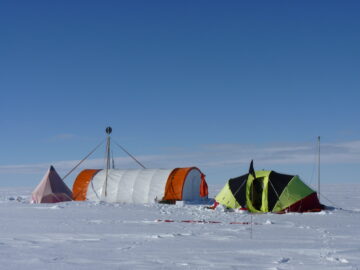
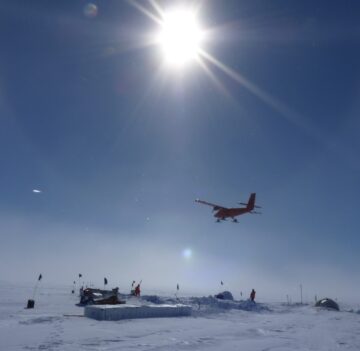
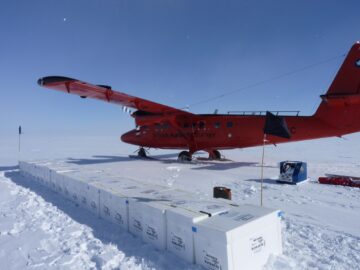
Ice core laboratories:
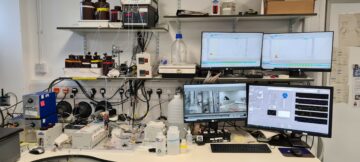

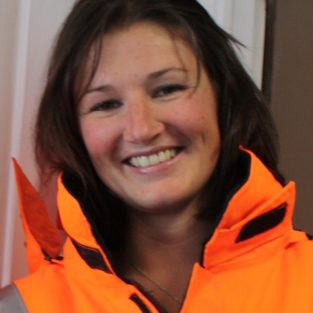
Jack Humby – Laboratory Manager
James Veale – Ice core drilling engineer
Using this facility:
Access to this facility is through funded collaborative research grants.
For more information, or to discuss a potential proposals, please contact the head of the ice core group (Liz Thomas; lith@bas.ac.uk) and the laboratory manager (Jack Humby; jacby@bas.ac.uk).
Please contact us at least 3-months before the call deadline to ensure that proposals can be fully costed and accommodated.
Please note that for projects involving ice core drilling, we operate with a 2-3 year lead time.
If you are interested in collaborating in ice core research, then please consider joining the annual UK-Ice core network (UK-ICON) meetings.
Next meeting:
18th & 19th September
